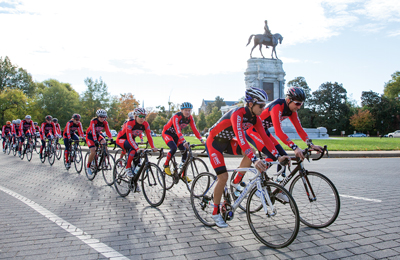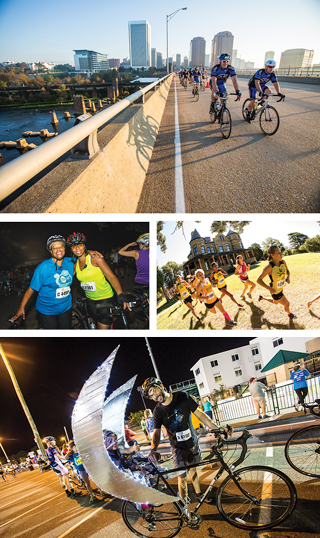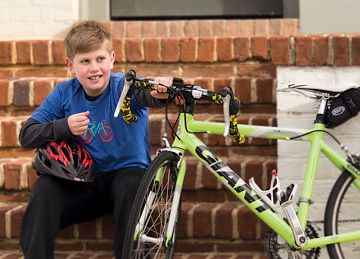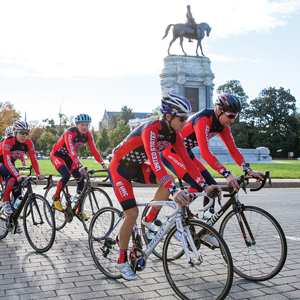Part Two in the RFM Series

Cycling is a hobby as well as a passion for 42-year-old Mike Lang. The New Kent resident rides his bike in Richmond at least once a week, mostly in city parks but also on city streets. He and his three children, all under the age of eleven, like to frequent Belle Isle Bike Skills Park, a small course underneath the Lee Bridge. “The kids just love it,” Lang says. “We’ll also do camping trips to places with bike trails.”
Lang, who has been riding bikes since he was five, is hesitant to let his children ride with him on city streets, however. “I don’t have a huge problem,” he says, concerning riding solo, “but you certainly need to look out for yourself. In the Fan, streets can get pretty congested and busy. People are looking out for cars. They are not looking for pedestrians or bicycles. That is probably where awareness needs to be raised the most.”
Bicycle awareness is an ongoing focus of Sports Backers’ Bike Walk RVA. The initiative started as an advocacy program to help spur development of more biking and walking infrastructure in the region. “We ran a campaign last year, Connect RVA, to get money allocated for the City of Richmond budget to allow for more space for bikers,” says Max Hepp-Buchanan, the program’s director. “The city has already put in a number of buffered bike lanes.”
In the last few years the city has installed nine miles of bike lanes and several miles of buffered bike lanes (lanes that have a buffer of three to five feet) as well as 235 bike racks around town. It currently has eighty lane miles of shared lane markings (called sharrows) with approximately fourteen more miles on tap this spring. “We are just doing a final review of the bike master plan with another fifty miles of bike lanes,” says Jakob Helmboldt, pedestrian, bicycle, and trails coordinator for the city. “The one-and-a-half mile segment of the Virginia Capital Trail in the city is heading toward completion as well.”
The Cannon Creek Greenway, which parallels Richmond-Henrico Turnpike, offers 1.75 miles of paved shared-use path. “And we are working on two other shared/greenways,” Helmboldt says.
But is that enough? According to a 2013 report by Sports Backers, “other U.S. cities comparable to the Richmond region far surpass the region in the miles of bicycle infrastructure currently on the ground, as well as what is planned for implementation in the coming years.” In 2013, the Richmond region had 18.25 miles of bike lanes and 145.7 miles of dirt trails scattered through various city parks.
Those numbers come up short when you compare them to Portland, Oregon, which, according to the survey, had 318 miles of bicycle infrastructure (both on- and off-street biking) or Minneapolis, which is often rated as the country’s best bike city.
Hepp-Buchanan estimates that about 60 percent of the people living in the region are interested in biking, but are concerned about their safety and their family’s safety on roads in the area. “Right now they don’t feel as comfortable,” he says.
He believes the Richmond area still has a “ways to go” to become a region that not only supports biking for transportation, but also appeals to all ages and abilities. “We are trying to make this a family-friendly bike region, not a region that just appeals to the strong and fearless riders in spandex, although they are important too. We want to leave a legacy behind.”
Sports Backers currently runs three events that help benefit Bike Walk RVA’s efforts. They are the family-oriented Anthem Moonlight Ride in August where riders dress up in costumes, decorate their bikes, and head out after dark on a secured course; the Maymont X-Country Festival, a trail running event; and The Martin’s Tour of Richmond. “The Martin’s Tour is held in October and it’s our big ride,” Hepp-Buchanan says. Riders can choose from the full 101-mile distance or three shorter courses.
When it comes to the international cycling scene, Lang believes Richmond is getting more credibility thanks to the city’s hosting of the 2015 UCI Road World Championships this September. The New Kent dad has already carved out a week of vacation to watch and also volunteer for some of the events associated with the race.
“It’s like having the Super Bowl come to Richmond,” he says of the championships. “It will attract people from all over the world. I am looking forward to seeing the professional races and the international crowd. It’s a pretty unique event for the U.S. and for Richmond.”
This will be the first time the event has been held on American soil since 1986. Recent host cities include Florence, Copenhagen, and Melbourne. Richmond 2015, the organization overseeing the race, expects 450,000 onsite spectators over nine days of racing as well as a thousand of the world’s best cyclists from seventy-five countries.
There will be twelve championship races in three disciplines: the traditional road race, individual time trial, and team time trial.
“When we first set out down this crazy road, one of the things we believed is that this is much more than a bike race,” says Tim Miller, chief operating officer of Richmond 2015. “Hosting something like this could be a catalyst for transformational change.”
He’s glad that Richmond is implementing improvement projects. “Richmond is not historically bike friendly,” he says. “It’s been surreal to see things starting to happen to make Richmond more bike friendly.”
Some of those projects may not have happened if the city wasn’t hosting the world championships. “They [the championships] provide a deadline,” Miller says of the races. “We have brought urgency. We’ve been that catalyst.”
The races will have an economic impact on the area – an estimated $128 million on the local region and a $158 million impact statewide. “It may not benefit people directly, but having that financial injection in the community benefits restaurants, retailers, and so forth,” Miller says. “It’s good for the community.”
Richmond 2015 is working on both entertainment and educational events during the race. “There will be a little bit of something for everyone, whether you are a bike racing fan or not,” Miller says. “When something this big comes to town, a lot of people will come and check out a little of the bike racing and participate in events.”

The organization is partnering with Sports Backers on Conquer the Cobbles, a pair of evening public-participation events taking place in conjunction with this year’s World Championships. The events include a running race and bike ride that will give participants a chance to experience the same road circuit course that will be contested by world competitors. The riding event will be limited to 2,015 entrants.
“Imagine getting the chance to play Augusta the day before The Masters or Centre Court during Wimbledon’s fortnight,” says Miller. “This truly is a unique opportunity for riders and runners to test themselves on the same course that will challenge the world’s best cyclists.”
Like Lang, biking enthusiast Glenn Amey is also thinking of taking a week off to view the races and participate in events. “I know a number of people that are going to do the same thing,” he says, adding that he will also take his four children, ages two to nine, to some of the events so they can have that experience. “This is once in a lifetime.”
Amey, who has lived in Richmond since 1990, bikes to work each day and his family bikes to school. “I feel totally comfortable riding in traffic year round,” he says, adding that Richmond has only a small segment of year-round riders.
He often takes his older two children to the James River Park System to ride the trails. “Belle Island is a fantastic resource,” he says. “It’s easy to access and there are several activities you can do on the island.”
When it comes to the biking culture in the city, Amey agrees that Richmond can do better. “There are so many progressive cities,” he says. He knows that many riders don’t feel comfortable riding in traffic. “There are ways to zigzag behind areas but they are not connected well,” he adds.
His biggest wish: Directly connect communities through the many corridors along the railroad tracks. “The railroad owns a wide piece of land and I wish some of that could be cleared for bicycle corridors,” he says. “People want to see greenways to connect communities.”
Richmond still has strides to make to become the next Portland in terms of biking infrastructure, but the city is on its way. “We are starting from a place some of the bike-friendly cities started ten years ago,” says Hepp-Buchanan. “They are ahead of us, but we have to start somewhere and there is huge momentum. There is a growing community of supporters for safe and comfortable infrastructure in Richmond and we have to keep going. We have gone from a city that forces bikes and cars to share the same busy streets to a city that is starting to prioritize protected spaces for people who want to ride bikes.”
photos courtesy: Sports Backers, Team USA photo by Josh Lopez
Bar Mitzvah and Biking – a Perfect Fit!

This past January 24 was a big day for 13-year-old Mitchell Marcus. He celebrated both his bar mitzvah and exceeding his goal of riding his bike 500 miles to raise money for Sports Backers’ Bike Walk RVA. His final count on that day: 514 miles.
“I wanted to do it before my bar mitzvah,” he says of meeting the goal. “I am definitely excited that I did it.”
His monetary goal of raising $5,000, however, is still ongoing – $4,000 and counting.
The Moody Middle School student came up with the idea of raising money for Bike Walk RVA to satisfy a community service project for his bar mitzvah. He settled on biking specifically after going with his older brother to look at colleges in Syracuse and Boston.
“We went to Syracuse and the main campus had really nice bike lanes,” he says, adding that he saw the same scenario in Boston. “I thought, ‘Hey, we need this in Richmond.’”
Mitchell became fond of biking after competing in his first triathlon at the Shady Grove YMCA. “Biking was my favorite part,” he says of the day. “My older brothers are runners, so biking was my thing.”
Mitchell’s dad, Rick, also bikes both solo and with the family, but admits he is concerned about safety on the roadways. “When we would go out for our rides there was lots of traffic we had to worry about,” he says.
After Mitchell told his dad about his idea, the two met with Max Hepp-Buchanan, director of Bike Walk RVA, to flesh out the details. “He helped us define how far to ride and how much to raise,” Rick says. “We wanted to do something significant.”
Hepp-Buchanan was surprised at Mitchell’s offer. “That was the first time I had someone contact us directly about wanting to help raise money for bicycle advocacy,” he says. “We wanted to work with him as much as we could.
Mitchell originally thought about riding a hundred miles and raising $1,000 but “my dad said I could do better,” he says, noting the five-fold increase they finally agreed upon.
To start the process, Sports Backers created a donation page and Rick began distributing flyers at his job. “We also put it on Facebook,” he says. When the invitations to the Bar Mitzvah went out, a note was added explaining what Mitchell was doing and telling people their donations would be appreciated.
Money for the project is being raised through the Sports Backers’ website. “We have already received $4,000, thanks to Mitchell,” Hepp-Buchanan says. The organization is putting that money toward different initiatives such as Bike Walk RVA Academy, which helps develop biking and walking advocates, and Connect RVA, helping to make the region a better place to bike and walk.
Mitchell clocked in the first miles toward his goal on February 22, 2014. He and his dad rode twelve miles that day, mostly in the Short Pump area, which isn’t exactly known for its bike-friendly roads. “We have loops we have mapped out,” Rick says.
When the Shady Grove YMCA’s triathlon was announced, Rick thought Mitchell would compete in the kids’ triathlon, which was taking place the day before the adult event. “He said, ‘No, I want to do the same one you are doing,’ so he did the full adult triathlon the next day,” Rick says. “The day he did the triathlon, he also had a soccer game in Virginia Beach.”
Most of Mitchell’s miles, 450 to be exact, were recorded outside. When the weather turned cold, he retreated inside to ride on a stationary bike.
The experience has benefitted Mitchell in several ways. “This has really gotten him in shape,” his dad says. He also learned how to “come up with a project, figure out how it’s going to work, and see it through.”
Mitchell is happy that he’s able to give back to the biking community. “I feel like I am helping out more than with some other projects,” he says. “It makes me feel good.”




